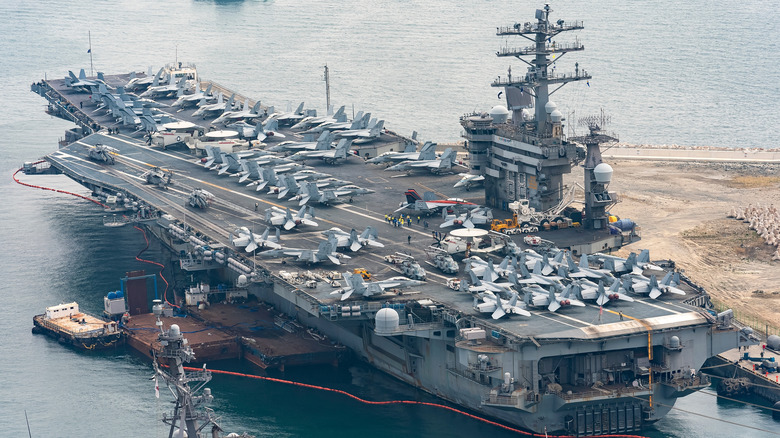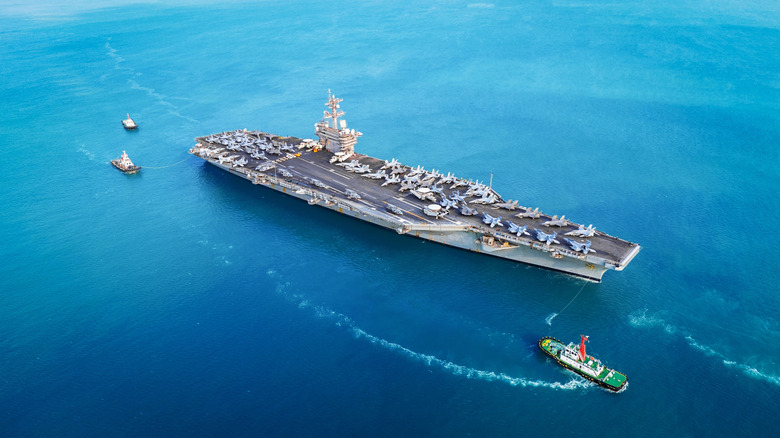The US Navy Is Working On A New Nuclear Supercarrier: Here's What We Know So Far
The history-making USS Nimitz is scheduled to be retired in May 2026. Officially launched in 1972, it was innovative at the time as an aircraft carrier that utilized nuclear power. The next carrier that will join the fleet to replace the USS Nimitz has some big shoes to fill. One ship was already expected to be its successor, the USS John F. Kennedy. However, continual problems have caused its completion date to be pushed back.
The USS John F. Kennedy was supposed to become part of the US Navy's fleet in 2025, but now it is not expected until March 2027. Even that date is a hopeful one. The main issues the John F. Kennedy has been facing include upgrades to be on the cutting-edge of naval warfare and technical hardware challenges with its arresting gear and weapons elevators.
Since the USS John F. Kennedy will not be ready by the time the USS Nimitz retires, the Navy's fleet will be down one ship. Given that the USS Nimitz continues to be active and important around the world as it closes in on retirement, that is a hole the John F. Kennedy will need to fill quickly. Once the nuclear supercarrier is done, however, it is sure to be an impressive addition to the fleet.
Key capabilities of the USS John F. Kennedy supercarrier
The USS John F. Kennedy belongs to the Gerald R. Ford class of aircraft carriers, which is the current, modern class of carrier, replacing the USS Enterprise and Nimitz class. Its construction began in 2009 and it is still not completely finished. It is costing billions of dollars to build this nuclear-powered war machine.
The John F. Kennedy is designed to carry 100,000 tons. It will be 1,105 feet long, with a 134-foot waterline beam and a 256-foot flight deck. Its nuclear power comes from two Bechtel A1B reactors, which are more powerful than those on the USS Nimitz. Nuclear energy has been essential in American aircraft carriers, which in Kennedy's case allows it to travel at up to 30 knots and hold up to 4,660 personnel.
The weapons systems that the USS John F. Kennedy boasts are impressive. It will have RIM-162 Evolved Sea Sparrow Missiles, RIM-116 Rolling Airframe Missiles, Phalanx Block 1B close-in weapon systems, and four .50 caliber heavy machine guns. Its flight deck will be able to accommodate 80 aircraft. As its purpose is, in fact, as an aircraft carrier, it is essential for its design to revolve around planes taking off and landing on it during missions around the world. If needed, the deck has been designed to hold an extra 10 aircraft.
The reasons for delay
One of the delays the John F. Kennedy faces is due to its system and operational upgrades. The systems being improved include the Enterprise Air Surveillance Radar and the ability to handle the F-35C Lightning II aircraft. The Enterprise Air Surveillance Radar is a multi-purpose radar meant to support air traffic control, provide electronic protection, and identify dangerous targets like drones, missiles, and other aircraft.
Finishing up the Advanced Arresting Gear for landing and launching aircraft has had its turmoil. This has mostly revolved around upgrading the system from being hydraulic-based to an electromagnetic turbo-electric design. Another problem has been the Advanced Weapons Elevators which use electromagnetic motors to lift weapons and ammunition from the storage area below up to the deck. These elevators are still being worked on and haven't yet operated as expected.
Despite all these delays, the USS John F. Kennedy is an exciting addition to the US Navy. Since the USS Nimitz showed the benefits of nuclear power, the military has continued that legacy in its carriers, and the US government is eager to build next-gen nuclear reactors to embrace this technology. We'll have to wait and see if the John F. Kennedy is ready to join the fleet come March 2027, and what lasting legacy it will leave of its own.


